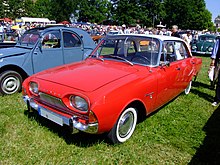Ford Taunus
The model line was named after the Taunus mountain range in Germany, and was first made in 1939, and continued through several versions until 1994.
[1] In total, 7,128 pre-war Taunuses (G93A) were made, including estate cars and light vans, followed by 76,590 post-war models (G73A).
Taunus was also sometimes adopted as the brand name in export markets, particularly where British and North American Fords were also available.
Growing prosperity in postwar Germany encouraged Ford to offer a line of bigger and more expensive cars.
It presented a style similar to American 1955 Fords, featuring substantial (at least by European standards) tailfins.
A road test of the time commended the smoothness of the three-speed, all-synchromesh manual transmission system.
[5] At a time when competitors boasted that all four corners of the vehicles were visible from the driver's seat, the new Taunus instead offered a streamlined form.
[6] However, in Germany the concept of streamlining in cars was associated with narrow passenger cabins reminiscent of the 1930s and of the still popular Volkswagen Beetle.
Ford offered a two- or four-door sedan or a five-door station wagon/estate (identified like previous Taunus estates as the Turnier).
The Taunus TC and Cortina Mk.III were both developed under the auspices of Ford of Europe, and most major components including key parts of the bodyshell were identical.
At the end of November 1975, in time for the 1976 model year, production began of the Taunus series "GBTS".
The Taunus and Cortina Mk IV were in most cases now almost identical, apart from regional variations (in terms of specification changes and trim levels).
The Taunus TC along with the Cortina Mk III and their successors have been produced in slightly updated forms in Europe, Argentina and widely across Asia by Ford or their local co-operators.
This led to the Cortina 80 at the end of its production life serving as a starting point for the first Hyundai Stellar which succeeded the Cortina line in South Korea, handing over some major technical components such as the steering rack and the transmission propelling shaft to the otherwise non-Ford successor.
The Sierra carried over the Cortina/Taunus OHC Pinto Engines and RWD configuration but was otherwise an all new car with independent suspension all round.
The Turkish car, easily distinguishable because of its remolded front and back panels continued in production until 1994.












